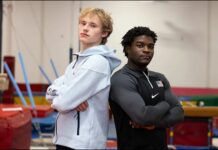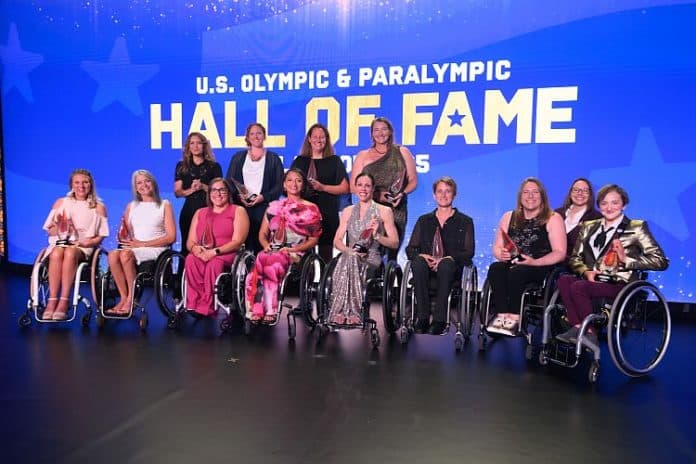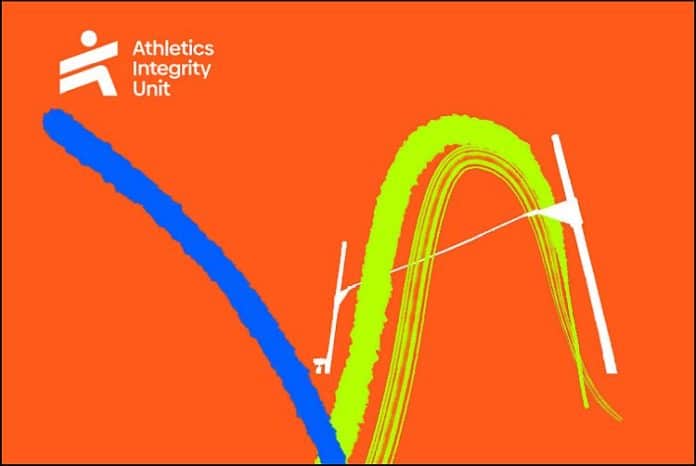★ The Sports Examiner is delighted to present this important contribution from our patron, the United States Olympic & Paralympic Committee, with a focus on American Paralympic stars. Opinions expressed are those of the USOPC. ★
Susan Hagel, Marla Runyan and Stephanie Wheeler of the 2004 U.S. women’s wheelchair basketball team reflected on the honor of being inducted.
By Bob Reinert
Red Line Editorial
When Susan Hagel began competing internationally in 1973, the world of adaptive sports was much different than it is today.
At the time, national team members were expected to compete in multiple sports to develop skill levels and increase the likelihood of earning medals. For Hagel, that meant practicing with the U.S. women’s wheelchair basketball team when she wasn’t honing her skills as an archer.
“You had to kind of prove your mettle, per se, in the different sports,” Hagel recalled. “The basketball team was made up of women doing other sports. So, if you weren’t competing in your primary sport, you were expected to be on the basketball court.”
In 1976, Hagel won gold in Para archery during her Paralympic Games debut in Toronto. By her sixth and final Games in 1996, she had won four golds and two bronzes across Para archery and wheelchair basketball, while also competing in track and field during the 1980 Games in Arnhem, The Netherlands.
For her versatility, Hagel earned a spot into the U.S. Olympic & Paralympic Hall of Fame Class of 2025, making her one of the 14 inductees that was honored this past Saturday (12th) in Colorado Springs, Colorado.
Along with Hagel, the Class of 2025 included three other Paralympic icons: sled hockey goalie Steve Cash, track-and-field star Marla Runyan and the entire 2004 U.S. women’s wheelchair basketball team. Cash did not attend the induction ceremony.
Despite accomplishments that stretch across six decades, Hagel was taken aback by her selection to the Hall of Fame.
“I was really surprised and shocked at this honor being given to me,” Hagel said. “I think it took quite a while for it to actually kind of sink in.”
Being a part of a Hall of Fame is nothing new for Hagel. She currently serves as a member of the National Wheelchair Basketball Association Hall of Fame committee, helping her stay active in the Paralympic Movement.
“I feel very proud of that in that I always was trying to establish opportunities for other people and wanting to advance the sport and being a mentor to people who are starting out,” Hagel said. “I think that progress that’s happened is just wonderful, but there’s still a lot of progress to be made. But we’re heading in the right direction.”
Like Hagel, Runyan competed in multiple sports during her international career, starring at track and field while also dabbling as a cyclist.
During her Paralympic debut in Barcelona 1992, Runyan brought home four gold medals in track and field. Over two Paralympic appearances, she earned five golds and one silver.
In 2000, Runyan made history by becoming the first visually-impaired athlete to make the U.S. Olympic Team. She placed eighth in the 1,500-meter in 2000 before earning a ninth-place finish in the 5,000-meter four years later.
She is still the only U.S. athlete to compete in the Paralympics and Olympics.
Runyan, who recently graduated from Syracuse University College of Law, said she hadn’t spent much time reflecting on her athletic career, so the Hall of Fame selection caught her off guard.
“It’s truly an honor, especially given my career was some time ago,” Runyan said. “You just get caught up in day-to-day life. It’s easy to forget all that work. The recognition, to me, is so important because it’s acknowledging what it took.”
The honor forced some self-reflection from Runyan, who realized how momentous the 1992 Paralympics were, but not because of the medals she won.
“The friendships with the other Para athletes … those are really special,” Runyan said. “I felt like there was just this connection that I developed from that experience. I remember in those ’92 Games the opening ceremonies and walking into the stadium.”
The Paralympic Movement was relatively new when Runyan competed. In the years since her completive career ended, she has continued to do her part.
In 2017, she began working with the Boston Marathon to establish new divisions in the race for adaptive athletes. Three years later, Boston became the first major marathon to have divisions for classified Para athletes, adding them for vision, lower-limb and upper-limb impairments. Runyan also advocated for increased prize money for the wheelchair division.
“Disparity, to me, just doesn’t have a place anymore,” Runyan said. “It never did. The athleticism is what I always want to put up front.”
Stephanie Wheeler entered the Hall of Fame as a member of the 2004 Paralympic gold medal-winning U.S. women’s wheelchair basketball team. She called that the most connected team she’d ever experienced.
“We all obviously had this goal of wanting to win a gold medal in Athens,” Wheeler said. “But more important and more long-lasting, I think [were] the bonds and the friendships that developed over the course of time we were together.”
The Americans hadn’t won a gold medal in the sport since 1988, and they had an inauspicious start in Athens, opening the tournament with a one-point loss to Australia.
They rallied from there to defeat three-time defending champion Canada in the semifinals and got their revenge in the gold medal game against Australia with a 56-44 win.
“We genuinely cared about each other and genuinely liked being around each other,” Wheeler said. “I think all of that makes a huge difference when you’re trying to do something as hard as winning a gold medal.
“We were pushed because we had never been in those moments before together. But I think it made it more exciting.”
The induction ceremony in Colorado Springs on Saturday marked the first time since the 2004 podium appearance that all the team members and staff had been in the same room together.
“I think that speaks volumes to just how connected our team was,” said Wheeler, “and how much we wanted to be here for each other.”
Wheeler won another gold medal as a player in 2008 and coached the U.S. to another gold in 2016. Since 2009, she has led the University of Illinois women’s wheelchair basketball program.
Prior to the induction ceremony, Wheeler said she and her teammates were experiencing a sense of disbelief and honor.
“You never think about something like this happening when you’re playing your sport,” Wheeler said. “You’re just thinking about being the best you can possibly be when the moment demands it. You’re never thinking something like this is going to come out of it.”
Bob Reinert spent 17 years writing sports for The Boston Globe. He also served as a sports information director at Saint Anselm College and Phillips Exeter Academy. He is a contributor to the USOPC on behalf of Red Line Editorial, Inc.
For more, please visit the USOPC Paralympic Educational Hub.
¶
★ The Sports Examiner: Chronicling the key competitive, economic and political forces shaping elite sport and the Olympic Movement.★
You can receive our exclusive TSX Report by e-mail by clicking here. You can also refer a friend by clicking here, and can donate here to keep this site going.
For our updated, 699-event International Sports Calendar for 2025, 2026 and beyond, by date and by sport, click here!























